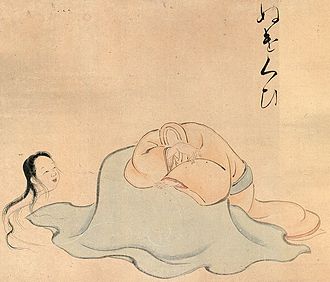Nukekubi
A nukekubi ( Japanese 抜 け 首 ; to dt. "Disappear neck") is a fictional being of the Japanese folk belief . He is a yōkai and is considered vicious. Nukekubi are very often confused with the similar rokurokubi .
description
Nukekubi are meant to look like ordinary people during the day. They prefer to pose as attractive women so as not to attract attention in the crowd. However, they reveal themselves through strange, red marks around their necks and necks, which they try to hide with scarves and high collars. At night, your body lays down to rest, while the head begins to lead a life of its own: While the body is at rest, the head detaches completely from the torso and floats nimbly around in search of sleeping or careless victims. If a victim is found, the head utters a high-pitched scream, which puts the victim into a freeze, then the Nukekubi bites and sucks blood. In contrast to the Rokurokubi, the Nukekubi has a particular weakness: If you manage to hide the body belonging to the detached head, the Nukekubi will not find its way back and will die at dawn.
folklore
A well-known legend comes from the Edo period and tells of a priest who was trained as a samurai in his youth . During a hike through a deep forest, the priest gets lost and meets a wealthy woodcutter, who offers him to spend the night with his extended family in his house. The priest gratefully accepts and at night he prays for the family. After the prayer, the priest wants to take a short walk behind the property when he discovers the headless corpses of the family members in the tatami room. Apparently the hosts have long been dead, although they had greeted him the night before. While the man examines the corpses, he discovers suspicious red marks on the base of their necks, and the priest has terrible suspicions. When he hears voices, he sneaks into the garden and sees the heads of the family members, floating in the air and quarreling loudly, planning the murder of the priest. Then the head of the woodcutter discovers the priest and the remaining heads attack the priest. Thanks to his samurai skills, the priest can destroy all heads except that of the logger. He tries to reach his body, but the priest blocks him with a sword blade. Because the priest had carefully hidden the body of the woodcutter beforehand, the woodcutter eventually dies and the curse on the property is broken.
background
The exact etymology of the name Nukekubi is not known. It is very likely that the first partial word, nuke , goes back to the Japanese 抜 け , which means “missing”, “cannot be found” and / or “disappeared”. Alternatively, the Japanese word nukeru can also be used, which translates as "slip away", "sneak away" and / or "steal away". Even the Japanologist , writer and traveler Lafcadio Hearn points to the many possible interpretations and suspects that it could be a word of Chinese origin. The second partial word in the name of the Yōkai, kubi , simply means "neck", "neck" and / or (less often) "neck".
The background of the belief in rokurokubi and nukekubi is very likely the phenomenon of sleepwalking . People who get out of bed in the middle of the night, soundly asleep and in a trance like normal people, and do everyday activities, led superstitious people to assume that the person concerned is possessed or in fact a disguised yōkai .
Legends about alleged encounters with Nukekubi and Rokurokubi are passed down from an early age and are still popular today. Lafcadio Hearn already collected legends and sagas about Nukekubi and Rokurokubi around 1950. Hearn already pointed out how difficult it is to mythologically separate the two beings from one another. Modern scholars, on the other hand, draw attention to descriptions in Hearn's reports, which suggest that Lafcadio Hearn reports from Nukekubi rather than Rokurokubi.
Nukekubi-like beings in other cultures
Vampire- like beings who can stretch their necks or loosen their heads are also known in other Asian cultures. In Malaysia, for example, a being called Penanggalan (in English “to detach himself from something”, symbolically “the headless”) is said to live, which sends its head on a journey during the night to attack sleeping people. According to Malay folklore, the Penanggalan was once a beautiful witch who was surprised by a man while taking a bath. She is said to have turned her head so quickly in shock that it downright tore off. Angrily, the head chased after the man and tore him to pieces (according to other versions, the head dragged the man into the water and drowned him).
literature
- Lafcadio Hearn: Kwaidan . Start Publishing LCC, Lanham 2013 (new edition), ISBN 1625586957 .
- Roxanne Hellman, Derek Hall: Vampire Legends and Myths . The Rosen Publishing Group, 2011, ISBN 1448859867 .
- Robin D. Gill: Kyôka: Japan's Comic Verse - A mad in Translation Reading . Paraverse Press 2009, ISBN 9780984092307 .
- Kazuhiko Komatsu: 妖怪 文化 研究 の 最 前線 . Serika Shobou, Tokyo 2009.
